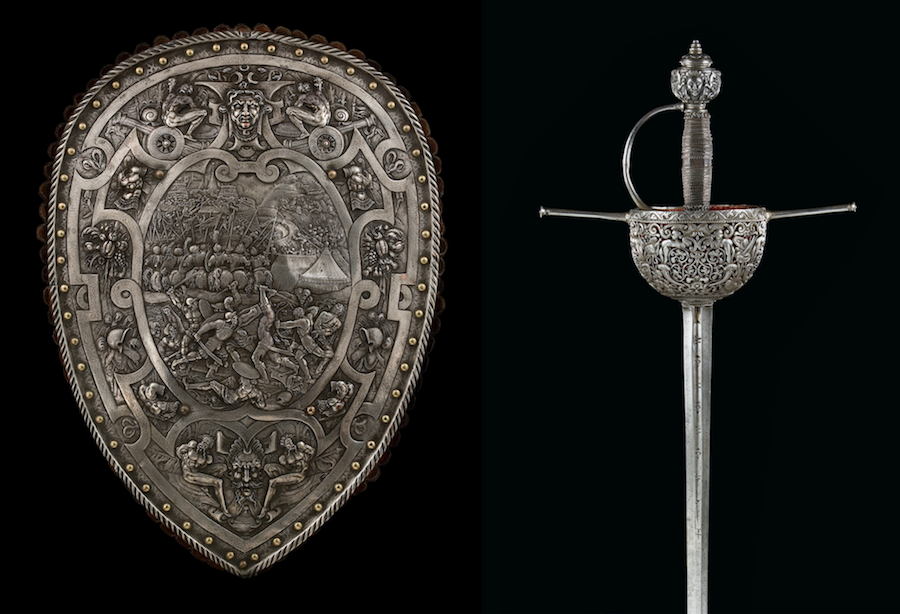Inside the Armor: Knights at The Ringling
Todays News
SRQ DAILY FRIDAY WEEKEND EDITION
FRIDAY FEB 1, 2019 |
BY PHILIP LEDERER
Pictured: Parade Shield, mid-late 19th century, and sword known as Spanish type, Italian-made, ca. 1670. Both on loan from Museo Stibbert.
Step inside the Ringling Museum time machine for a trip back to the age of chivalry, of lords and ladies and jousts and dragon-slayers, with the latest special exhibition—Knights. Presented in the Searing Galleries, the extensive installation spans five rooms and features more than 100 artifacts, exploring the role of the iconic warrior from the Medieval Age and Renaissance up through the Gothic Revival of the 19th century, all the while celebrating the artistry behind the armament. “They are, at this level, art objects in themselves,” says Ringling Museum Curator of Collections Dr. Sarah Cartwright.
The exhibition opens at full gallop, with two mounted figures in full plate armor, one equipped for the joust, atop similarly armored steeds dominating the middle of the room, reminding audiences of the full magnificence of this now-mythic archetype they’ve come to explore. Like most of the artifacts on display throughout the exhibition, the majority comes from the 16th and 17th centuries. Informational displays to either side introduce concepts of chivalry and feudalism, offering some historical and cultural framing of what’s to come. A saddle in the corner offers up-close examination of careful engraving.
Progressing through the exhibition, each room presents something of an explorative deconstruction of that opening salvo, breaking down the arms and armor into disparate parts and showcasing stylistic deviation and evolution. In one gallery, see a full German suit of armor in the Maximilian style, its fluted design famous in the early 16th century, but dying out by 1525, in favor of Italian influences, also available for viewing. See polearms on display and a great two-handed sword looking like something out of a nightmare. And see ornamental maces and 17th century portraiture signaling armor’s transformation from battlefield necessity to fashion accessory. Next to a full suit of jousting armor, a helpful diagram breaks down the many interlocking pieces, from comb to sabaton.
In another gallery, the knight’s most iconic weapon—the sword—takes center-stage. With 17 weapons on display (18, counting the one with the full suit of armor in the middle of the room.), trace the “final flourishing and decline of the sword,” says Cartwright, as it (d)evolves from weapon of war to another “gentlemanly” appurtenance. See blades made in Toledo, Spain, and ornate hilts from Italy, France and the Netherlands. Spot one in the 18th century Rococo style, with a porcelain grip. “Clearly not made for battle,” quips Cartwright.
And, soon enough, none of it would be, as the next room dedicates itself to individual pieces of armor as art, from oversized helmets to extravagant greaves, but ending with a preserved flintlock and gun barrel looming next to a cuirass pierced through with a gaping bullet hole. The time of the knight would come to an end as well.
Organized by Contemporanea Progetti and the Museo Stibbert in Florence, Italy—the same institutions behind the 2016 Samurai: The Way of the Warrior exhibition—Knights opens this Sunday, and runs through April 21.
Pictured: Parade Shield, mid-late 19th century, and sword known as Spanish type, Italian-made, ca. 1670. Both on loan from Museo Stibbert.
« View The Friday Feb 1, 2019 SRQ Daily Edition
« Back To SRQ Daily Archive











